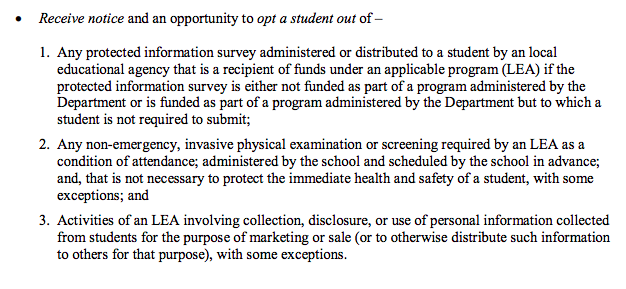Opting Out
Resources
What does it mean to opt out?
Many parents are asking about the option of opting out of certain types of instruction. When it comes to “Social and Emotional Learning,” commonly referred to as “SEL,” we are receiving an increasing number of requests for what opting out means, how to opt out and what parents’ rights are regarding opting out. Depending on the state in which you live, you may have the option of opting your child out of specific curriculum – or even testing. A federal law, the Protection of Pupil Rights Amendment (PPRA), allows all students to opt out of surveys.
Should you wish to opt your child out, all requests should be made in writing – and need to be resubmitted annually.
Do parents have a right to opt children out of aspects of school?
Opting out is exercising your parental right to have your child not participate in certain types of instruction. Opting out is a formal process that typically requires written notification or completion of an opt-out form distributed by your school. School districts have differing policies on whether or not students can opt-out of social and emotional learning. It can be difficult to opt out of this type of instruction because we are increasingly seeing the instruction make its way into all aspects of the curriculum.
What is the process to opt out?
Parents should ask their principals what the opt-out process is in their district. Many have district-specific opt-out forms that simply need to be signed and turned in to school officials. Keep a copy of your form. If your child has a phone, have your child take a picture of the form. Follow up with your school to make sure the form was recorded. If your district does not provide an opt-out form, ask how to opt out. Some districts do not want students to opt out, so they do not make the opt-out forms readily available and they do not publicise your right to opt out.
As it relates to social and emotional surveys, like those conducted by Panorama Education, parents do have the right under PPRA to opt out. Your school should provide the option to opt out with a link to the opt-out form. If they do not, contact your school and ask where to obtain the opt-out form. The opt-out forms can be submitted anytime but it is advised to opt out as soon as the surveys are announced — usually in September at the beginning of the school year. There is often a data-share aspect of the survey process where school districts share students’ personally identifiable data with the companies that will be conducting the survey. The earlier in the process you notify your school of your desire to opt out, the less data may be shared about your child with the outside vendor. Ask your school what personally identifiable data will be shared with outside companies and consultants.
Parents should follow school communications to be aware of what social and emotional learning is planned at your school and when, so you can discuss the schedule with your child. For students who opt out, parents should communicate with your school and find out what your child will be doing during the time that is carved out for SEL. Students who have opted out of SEL typically stay in the classroom and read during the SEL lesson or leave the classroom and report to the library, cafeteria or theater.
What are my rights regarding opting out?
Unfortunately, the ability to opt out of educational material is not universal. The majority of state laws were written specifically with sex and health instruction in mind. Some states – like Idaho, Missouri and Massachusetts – drafted their laws to apply only to sex-ed. California law expressly limits opt outs to very narrow categories within sex-ed. Other laws, like in Iowa, apply more broadly to any health topics. And a few states have very narrow opt-out protections for AIDS-prevention instruction only.
Parents should ask their school what their district policies are on opting out of SEL instruction. Parents have the right to ask to see lessons and material, including copies of the SEL surveys, prior to instruction. Under Federal Law, parents do have the right to opt their students out of surveys. The Protection of Pupil Rights Amendment, commonly referred to as PPRA, gives parents this right.
What if my child attends a private school?
The Protection of Pupil Rights Amendment only applies to schools that receive federal funding, so it does not apply to all private schools. But private school parents can still take steps to protect their children from harmful ideologies in the classroom.
Most private schools recognize that parents have the primary responsibility for educating their children and expect parental involvement and close communication. It is reasonable to ask to be notified and to have the option to opt your child out of any surveys, lessons, readings, classroom presentations, or pedagogical practices that you feel violate your child’s human dignity or your parental rights. Requests should be made in writing. See tips for writing an opt-out letter to your child’s private school here.
What does the Protection of Pupil Rights Amendment (PPRA) say?

Should I opt my child out of taking surveys at school?
Well, that depends.
Some school surveys are harmless. An example of this would be: “What do you prefer for a Senior Gift” or “What should the theme of Homecoming be this year?” These types of surveys are fun and can contribute to school spirit and camaraderie. There is nothing intrusive about them and parents are not entitled to an “opt out” under the law.
Parents may want to opt their child out of other more invasive surveys that ask invasive and personal questions and, under federal law, they have a right to do so.
The Protection of Pupil Rights Amendment (PPRA) guarantees parents this right if a survey includes the questions about the following subjects:
- political affiliations or beliefs of the student or the student’s parent
- mental or psychological problems of the student or the student’s family
- sex behavior or attitudes
- illegal, anti-social, self-incriminating, or demeaning behavior
- critical appraisals of other individuals with whom respondents have close family relationships
- legally recognized privileged or analogous relationships, such as those of lawyers, physicians, and ministers
- religious practices, affiliations, or beliefs of the student or student’s parent
- income (other than that required by law to determine eligibility for participation in a program or for receiving financial assistance under such program).
The best way to determine if you would like to exercise your rights under federal law to opt your child out of certain types of surveys is to review the survey BEFORE it is given to your child—which you also have a right to do under the PPRA. You can set up a time with the school to review the survey and decide if you think it has value or is appropriate for your child.
Schools often send an email about an upcoming survey with very little notice—sometimes it’s barely 24 hours notice. This practice does not allow sufficient time for a parent to review the survey to decide if they prefer to opt out their child.
Ask your school what surveys will be administered and when. Then ask to review those surveys.

Additional Resources
- State-Specific Public School Opt-Out Forms, Pacific Justice Institute
- Parental Consent Letter, America First Legal
- The legal balancing act over public school curriculum, Phi Delta Kappan
- Question & Answer Guide On California’s Parental Opt-Out Statutes: Parents’ and Schools’ Legal Rights And Responsibilities Regarding Public School Curricula, California Safe Schools Coalition
- The Protection of Pupil Rights Amendment: A Toolkit For Parents, America First Legal
- Protection of Pupil Rights Amendment (PPRA), United States Department of Education Student Privacy Policy Office
- Data Mining Your Child: What You Can Do To Stop It (Opt Out), Courage Is A Habit
- You Submitted a Survey Opt-Out. Now What?, Defending Education
- Opt Out Requirement after Mahmoud v. Taylor Supreme Court Ruling, Defending Education
Stay Informed

